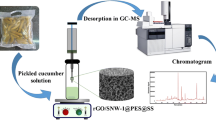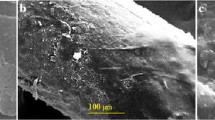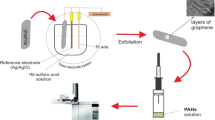Abstract
A new unbreakable solid-phase microextraction fiber coating based on polyethylene terephthalate/graphene nanocomposite was developed. The nanocomposite coatings were prepared by an electrospinning technique using a polyethylene terephthalate (PET) polymer solution containing the dispersed graphene on the outer surface of a stainless-steel rod. The applicability of polyethylene terephthalate/graphene nanocomposite coatings was examined by extraction of organochlorine compounds (OCs) including heptachlor epoxide, aldrin, γ-HCH, and β-HCH from aqueous samples in headspace mode. Influential parameters on extraction efficiency such as polymer concentration, the weight ratio of components, the electrospinning time, time and temperature of extraction, the salt concentration, and desorption condition were investigated. Eventually, the developed method was validated by gas chromatography micro electron capture detector (GC-µECD). At the optimum conditions, the intra-day relative standard deviations for the determination of chloro compounds in distilled water spiked at the levels of 400, 800, and 1500 ng L− 1 were 1.9–7.3% (n = 3), the limit of detection is between 5 and 30 ng L− 1, and the calibration plots cover the 100 to 5000 ng L− 1 range. Inter-day precision values obtained for three replicates measured on different days were in the range of 2.6–9.5% at concentration levels of 400, 800, and 1500 ng L− 1. The method was applied to the analysis of (spiked) water samples and relative recoveries were found to range from 81 to 106%.






Similar content being viewed by others
References
Li Z, Romanoff LC, Trinidad DA, Hussain N, Jones RS, Porter EN, Patterson DG Jr, Sjôdin A (2006) Measurement of urinary monohydroxy polycyclic aromatic hydrocarbons using automated liquid-liquid extraction and gas chromatography/ isotope dilution highresolution mass spectrometry. Anal Chem 78:5744–5751
Smith CJ, Huang WL, Walcott CJ, Turner W, Grainger J, Patterson DG Jr (2002) Quantification of monohydroxy-PAH metabolites in urine by solid-phase extraction with isotope dilution-GC–MS. Anal Bioanal Chem 372:216–220
Mei M, Huang XJ, Yang XD, Luo Q (2016) Effective extraction of triazines from environmental water samples using magnetism-enhanced monolith-based intube solid phase microextraction. Anal Chim Acta 937:69–79
Xu HL, Li Y, Jiang DQ, Yan XP (2009) Hydrofluoric acid etched stainless steel wire for solid-phase microextraction. Anal Chem 81:4971
Djozan D, Bahar S (2004) Solid-phase microextraction of aliphatic alcohols based on polyaniline coated fibers. Chromatographia 59:95–99
Farajzadeh MA, Rahmani NA (2005) Electrolytically produced copper(I) chloride on the copper wire as an excellent sorbent for some amines. Talanta 65:700–704
Djozan D, Abdollahi L (2003) Anodized zinc wire as a solid-phase microextraction fiber. Chromatographia 57:799–804
Azenha MA, Nogueira PJ, Silva AF (2006) Unbreakable solid-phase microextraction fibers obtained by sol-gel deposition on titanium wire. Anal Chem 78:2071–2074
Budziak D, Martendal E, Carasek E (2008) Preparation and characterization of new solid-phase microextraction fibers obtained by sol-gel technology and zirconium oxide electrodeposited on NiTi alloy. J Chromatogr A 1198–1199:34–39
Rutledge GC, Fridrikh SV (2007) Formation of fibers by electrospinning. Adv Drug Deliv Rev 59:1384–1391
Chigome S, Darko G, Buttner U, Torto N (2010) Semi-micro solid phase extraction with electrospun polystyrene fiber disks. Anal Methods 2:623–626
Bagheri H, Ayazi Z, Aghakhani A, Alipour N (2012) Polypyrrole/polyamide electrospun-based sorbent for microextraction in packed syringe of organophosphorous pesticides from aquatic samples. J Sep Sci 35:114–120
Bagheri H, Aghakhani A, Baghernejad M, Akbarinejad A (2012) Novel polyamide-based nanofibers prepared by electrospinning technique for headspace solid-phase microextraction of phenol and chlorophenols from environmental samples. Anal Chim Acta 716:34–39
Wang H, Ding J, Lee B, Wang X, Lin T (2007) Polypyrrole-coated electrospun nanofibre membranes for recovery of Au (III) from aqueous solution. J Membr Sci 303:119–125
Chen J, Zou J, Zeng J, Song X, Ji J, Wang Y, Ha J, Chen X (2010) Preparation and evaluation of graphene-coated solid-phase microextraction fiber. Anal Chim Acta 678:44–49
Yavuz H, Guler GO, Aktumsek A, Cakmak YS, Ozparlak H (2010) Determination of some organochlorine pesticide residues in honeys from Konya. Turkey Environ Monit Assess 168:277–283
Campillo N, Penalver R, Aguinaga N, Hernández-Córdoba M (2006) Solid-phase microextraction and gas chromatography with atomic emission detection for multiresidue determination of pesticides in honey. Anal Chim Acta 562:9–15
Author information
Authors and Affiliations
Corresponding author
Ethics declarations
Conflict of interest
All authors declare that they have no conflict of interest.
Ethical approval
This article does not contain any studies with human participants or animals performed by any of the authors.
Rights and permissions
About this article
Cite this article
Najarzadegan, H., Roostaie, A. & Ehteshami, S. Electrospun Polyethylene Terephthalate/Graphene Nanocomposite as a New Solid-Phase Microextraction Fiber Coating for Enhanced Determination of Organochlorine Compounds. Chromatographia 81, 1413–1420 (2018). https://doi.org/10.1007/s10337-018-3583-4
Received:
Revised:
Accepted:
Published:
Issue Date:
DOI: https://doi.org/10.1007/s10337-018-3583-4




